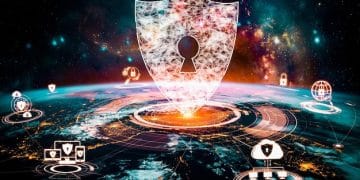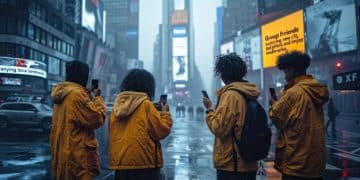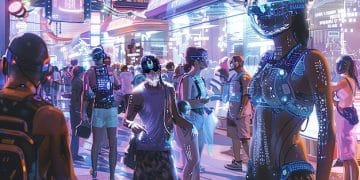Critical Thinking in the Information Age: Fact vs. Fiction

Critical thinking in the information age is paramount for discerning truth from falsehood, enabling individuals to navigate the complex landscape of misinformation and make informed decisions in a world inundated with data.
In our increasingly interconnected world, where information flows ceaselessly from myriad sources, the ability to engage in critical thinking in the information age: separating fact from fiction in a world of misinformation has never been more vital. Navigating this ocean of data requires more than just passive consumption; it demands active, discerning analysis.
the relentless tide of misinformation
The digital era has ushered in an unprecedented flood of information, making it challenging for individuals to distinguish between reliable sources and deceptive content. Misinformation, disinformation, and malinformation spread rapidly through social media, news outlets, and personal networks, often blurring the lines between truth and falsehood. This phenomenon, amplified by algorithms and echo chambers, can significantly influence public opinion, elections, and even individual well-being. Understanding the mechanisms behind this spread is the first step toward effective mitigation and fostering a more informed society.
The sheer volume of content available today means that critical thinking skills are constantly being tested. It’s no longer just about identifying outright lies; it’s about recognizing subtle biases, incomplete narratives, and intentionally misleading frameworks. The speed at which information travels also allows falsehoods to gain traction before legitimate fact-checking can occur. This creates a fertile ground for confusion and distrust, eroding the very foundations of shared understanding and democratic discourse. Therefore, developing a robust framework for evaluating information becomes a personal and collective responsibility.
understanding the roots of misinformation
Misinformation often stems from various sources, ranging from innocent errors to deliberate manipulation.
- Cognitive biases: People tend to interpret information in a way that confirms their existing beliefs, making them more susceptible to narratives that align with their worldview.
- Emotional appeals: False information frequently preys on strong emotions like fear, anger, or hope, bypassing rational thought.
- Algorithmic amplification: Social media algorithms prioritize engagement, often boosting sensational or emotionally charged content, regardless of its accuracy.
The motivations behind spreading misinformation can also vary. Some individuals or groups aim to gain political advantage, while others might seek financial profit through clickbait or advertising revenue. Understanding these underlying motives can help in identifying potentially unreliable content. Moreover, the lack of media literacy education in many curricula leaves a significant portion of the population unprepared to deal with these sophisticated tactics, making them easy targets for manipulation. This points to a systemic issue that requires broad educational reforms to empower citizens to become more critical consumers of content.
The interconnected nature of digital platforms means that a piece of misinformation can originate in one niche community and quickly spread globally, transforming local falsehoods into widespread beliefs. This global reach, combined with the anonymity that online platforms can provide, emboldens those who seek to deceive. Consequently, the challenge is not just to educate individuals but also to demand greater accountability from technology companies regarding the content shared on their platforms.
the foundational elements of critical thinking
Critical thinking is not merely about doubting everything; it is a systematic process of evaluating information, identifying assumptions, considering alternative perspectives, and making reasoned judgments. It involves a set of cognitive skills and dispositions that, when employed consistently, can significantly enhance one’s ability to separate fact from fiction. These skills are not innate; they can be developed and refined through practice and intentional effort. Cultivating these elements provides a strong defense against the onslaught of misleading narratives.
At its core, critical thinking is about asking the right questions. It requires an inquisitive mind that delves beyond surface-level information to uncover deeper truths and potential inconsistencies. This active engagement with content transforms passive reception into an analytical process, allowing individuals to construct more accurate and nuanced understandings of complex issues. Without these foundational elements, individuals are left vulnerable to manipulation and are more likely to accept narratives without proper scrutiny.
key components of effective analysis
Developing critical thinking involves mastering several core components.
- Information literacy: The ability to locate, evaluate, and effectively use information from various sources.
- Logical reasoning: Understanding how arguments are constructed and identifying fallacies or inconsistencies.
- Bias recognition: Identifying one’s own biases and those present in the information being consumed.
Beyond these, critical thinking also involves a degree of intellectual humility, acknowledging that one’s own beliefs might be flawed and being open to changing one’s mind in the face of new evidence. This flexibility is crucial in a rapidly evolving information landscape. It also requires the discipline to follow a line of reasoning to its logical conclusion, even if that conclusion is uncomfortable or challenges preconceived notions. This commitment to intellectual honesty forms the bedrock of sound critical thought.
Furthermore, critical thinking encourages empathy and the ability to understand different perspectives, even those that contradict one’s own. This doesn’t mean agreeing with them, but rather understanding the reasoning and context from which they arise. Such an approach fosters more constructive dialogue and reduces polarization, which is often exacerbated by simplistic interpretations of complex issues. It moves individuals beyond knee-jerk reactions to more thoughtful and considered responses.
strategies for evaluating information sources
In the information age, the source of information is often as important as the information itself. Learning to critically evaluate sources is an essential skill for anyone aiming to discern fact from fiction. This involves looking beyond sensational headlines and delving into the credibility, transparency, and potential biases of the originators of content. Without this critical assessment, even seemingly factual information can lead to erroneous conclusions.
The internet’s decentralized nature means that anyone can publish anything, making it imperative to employ rigorous vetting processes. Developing a systematic approach to source evaluation can significantly improve one’s ability to identify reliable information and avoid falling prey to deceptive content. This requires a certain level of skepticism, not cynicism, that prompts further investigation rather than immediate acceptance.
the s.i.f.t. method and beyond
A popular and effective method for source evaluation is S.I.F.T. (Stop, Investigate the Source, Find Better Coverage, Trace Claims to Original Context).
- Stop: Before sharing or believing, pause and consider the information.
- Investigate the source: Look up the website, publication, or author to understand their background and potential biases.
- Find better coverage: Search for what other reputable sources are saying about the same topic.
- Trace claims to original context: Follow links back to the original research, reports, or statements to ensure accuracy.
Beyond S.I.F.T., it’s also crucial to consider the format and presentation of the information. Legitimate news organizations typically adhere to certain editorial standards, including clear attribution, correction policies, and professional design. Conversely, many misinformation sites often feature poor grammar, sensational language, clickbait headlines, and an abundance of pop-up ads, which serve as red flags. Examining the “About Us” page for transparency or looking at the age of a website can also provide valuable clues about its reliability. A site that has existed for a long time with a consistent editorial stance is generally more trustworthy than a newly created one.
Another important strategy is to cross-reference information. If multiple credible and independent sources report the same facts, it increases the likelihood of accuracy. However, if a piece of information is only found on a single, obscure website, it warrants a much higher degree of skepticism. This cross-verification process serves as a powerful antidote to cherry-picked data or isolated claims that might be presented out of context. Furthermore, being aware of “astroturfing” – the practice of masking the sponsors of a message or organization to make it appear as though it originates from grassroots participants – is crucial. This is a more sophisticated form of deception that requires a keen eye for unusual patterns in messaging or coordinated efforts across disparate platforms.

navigating cognitive biases and emotional appeals
Our brains are hardwired with various cognitive biases that can unknowingly influence how we perceive and process information. These mental shortcuts, while sometimes useful for efficiency, can also make us vulnerable to misinformation, especially when it taps into our emotions. Recognizing and counteracting these biases is a cornerstone of effective critical thinking. Understanding how they operate provides a powerful tool for self-reflection and more objective analysis.
Misinformation often thrives by exploiting these biases, using emotionally charged language or images to bypass rational assessment. When information triggers strong feelings, it can overshadow our ability to apply logic and scrutinize evidence. Therefore, developing emotional intelligence alongside intellectual rigor is crucial in the fight against deceptive narratives. It allows for a momentary pause, enabling a more measured response rather than an impulsive one.
common cognitive pitfalls and how to avoid them
Several biases commonly affect our judgment in the information age.
- Confirmation bias: The tendency to seek out and interpret information that confirms one’s existing beliefs.
- Availability heuristic: Overestimating the likelihood of events that are easily recalled or vivid in memory.
- Bandwagon effect: The tendency to do or believe things because many other people do or believe the same.
To mitigate these biases, actively seek out diverse perspectives, even those that challenge your worldview. Engage in “devil’s advocate” thinking, consciously trying to find flaws in arguments you agree with. Practice metacognition – thinking about your own thinking process – to identify when emotions or pre-existing beliefs might be swaying your judgment. When confronted with information that evokes a strong emotional response, take a step back and ask yourself why you feel that way before accepting it as truth. This deliberate distance allows for a more rational assessment of the content itself, rather than reacting solely to its emotional triggers. Cultivating this internal pause is a powerful technique for critical evaluation.
Furthermore, consider the source’s intent. Is the information designed to inform, persuade, or provoke? Understanding the motivation behind a piece of content can reveal inherent biases. For instance, an article from an advocacy group might present facts selectively to support its cause, whereas a scientific journal aims for objective reporting. Being aware of these motivations helps individuals adjust their level of scrutiny and look for corroborating evidence from more neutral sources. This conscious effort to identify and address personal and external biases is what truly distinguishes a critical thinker from a passive consumer of information.
the role of technology and media literacy
Technology plays a dual role in the information age: it is both the primary vehicle for the spread of misinformation and a powerful tool for combating it. Developing strong media literacy skills, coupled with an understanding of how digital platforms operate, is fundamental to navigating this complex landscape. Without these competencies, individuals risk becoming unwitting participants in the amplification of falsehoods.
Media literacy extends beyond simply knowing how to use digital tools; it encompasses the ability to understand the underlying structures, algorithms, and economic incentives that shape the information we consume. It equips individuals with the capacity to deconstruct media messages, identify their purposes, and evaluate their credibility. This holistic understanding is crucial for fostering a resilient and informed citizenry capable of independent thought.
empowering individuals through knowledge
Enhancing media literacy involves several key areas.
- Understanding algorithms: Learning how social media feeds and search results are personalized can reveal why certain information appears.
- Recognizing manipulative tactics: Identifying common techniques like clickbait, deepfakes, and propaganda.
- Promoting digital citizenship: Encouraging responsible online behavior, including fact-checking before sharing.
Educational institutions, governments, and even technology companies have a role to play in promoting media literacy. Integrating critical thinking and digital literacy into school curricula from an early age can equip future generations with the necessary tools. Public awareness campaigns can also help adults develop these crucial skills. Moreover, understanding the business models of media organizations and digital platforms can shed light on why certain types of content are prioritized. For example, revenue models based on “clicks” can incentivize sensationalism over accuracy. This financial aspect is often overlooked but profoundly impacts the quality of information available. Recognizing these systemic forces allows individuals to be more strategic in their information consumption.
Furthermore, media literacy encourages active participation in the digital sphere, not just passive consumption. This means contributing to a more truthful information environment by carefully verifying facts before sharing, reporting misinformation, and engaging in constructive dialogue. It transforms individuals from mere users into active agents of a healthier information ecosystem. This proactive stance is essential for creating a collective defense against the pervasive nature of disinformation campaigns. It shifts the responsibility from solely platform providers to a shared commitment from all who engage online.

cultivating a mindset of intellectual humility and open-mindedness
Beyond specific strategies and skills, critical thinking in the information age: separating fact from fiction in a world of misinformation also requires a fundamental shift in mindset. Cultivating intellectual humility and open-mindedness is paramount for truly engaging with complex issues and resisting the seductive pull of simplistic narratives. This approach means being comfortable with uncertainty and continuously seeking to improve one’s understanding, rather than clinging rigidly to existing beliefs.
In a world often polarized by seemingly absolute truths, intellectual humility allows for dialogue and learning across divides. It acknowledges that human understanding is inherently limited and that no single individual or group possesses a monopoly on truth. This disposition fosters a continuous learning process, making one more adaptable and resilient in the face of evolving information. Without this foundational humility, critical thinking can quickly devolve into mere argumentation or confirmation of pre-existing biases.
embracing complexity and ambiguity
An open-minded approach embraces the nuances and complexities of reality.
- Questioning assumptions: Regularly challenging one’s own underlying beliefs and preconceptions.
- Seeking diverse perspectives: Actively engaging with viewpoints that differ from one’s own, even those that seem contradictory.
- Being comfortable with uncertainty: Accepting that not all questions have immediate or simple answers, and some truths may remain elusive.
This mindset encourages a deeper, more reflective engagement with information, moving beyond black-and-white thinking to appreciate the shades of grey. It means being willing to admit “I don’t know” or “I need to learn more” rather than defaulting to an uninformed opinion. Such intellectual honesty is a powerful bulwark against the oversimplification and false certainty often propagated by misinformation. It also fosters resilience when confronting conflicting evidence, allowing for careful deliberation rather than impulsive rejection. The ability to hold conflicting ideas in mind and explore their implications is a hallmark of sophisticated thought. It prevents premature closure of inquiry and keeps the door open for new discoveries.
Furthermore, open-mindedness guards against the dehumanization of those who hold different views. When we approach others with a willingness to understand their perspectives, even if we ultimately disagree, it fosters empathy and reduces the likelihood of resorting to ad hominem attacks or dismissive labels. This is crucial for constructing a more civil and productive public discourse, which is often severely damaged by dogmatic adherence to one’s own beliefs without considering the merits of others. It means listening to understand, not just to respond, creating bridges rather than walls in the exchange of ideas.
the future of critical thinking as a vital skill
As technology continues to advance, and the digital landscape becomes even more intricate, the demand for sophisticated critical thinking skills will only intensify. Automation, artificial intelligence, and personalized information feeds all present new challenges and opportunities for how we interact with knowledge. Therefore, nurturing critical thinking is not just about navigating today’s misinformation; it’s about preparing for an unpredictable future.
Critical thinking will evolve from a desirable trait to an indispensable survival skill in both personal and professional domains. In an era where information is abundant but wisdom is scarce, the ability to synthesize, evaluate, and apply knowledge effectively will determine individual and societal success. This includes the capacity to adapt to new forms of information, such as deepfakes or AI-generated content, which present novel challenges for discernment.
preparing for an evolving information ecosystem
Future skills related to critical thinking encompass adaptability and continuous learning.
- Algorithmic literacy: Understanding how AI influences information presentation and content creation.
- Ethical AI engagement: Critically evaluating AI-generated content and recognizing its limitations and biases.
- Lifelong learning: Committing to continuous skill development to keep pace with technological and informational changes.
The rise of generative AI, for instance, means that distinguishing between human-created and machine-generated content will become increasingly difficult. Critical thinkers of the future will need new tools and frameworks to assess the authenticity and intent behind such content. This will require a blend of technical understanding and traditional humanistic inquiry. Furthermore, the ability to collaborate effectively in diverse and globally connected teams will also rely on strong critical thinking skills. It means being able to respectfully challenge ideas, synthesize varied inputs, and arrive at sound conclusions as a collective. The very nature of work is evolving, placing a premium on analytical rigor and problem-solving capacities that transcend rote memorization. These are the hallmarks of a truly adaptive mind.
Ultimately, fostering critical thinking is an investment in human agency and autonomy. It empowers individuals to resist manipulation, make informed decisions, and contribute meaningfully to their communities. It moves them from being passive recipients of information to active participants in shaping a more truthful and equitable world. This ongoing development of cognitive abilities is not merely an academic pursuit; it is a societal imperative that underpins democratic function and personal freedom in a world brimming with complex challenges and endless data. It is the compass that guides us through the fog of confusion. It will continue to be a cornerstone of human intelligence, ensuring our capacity to thrive amidst constant change.
| Key Aspect | Brief Description |
|---|---|
| 🔍 Misinformation Impact | Distorts public opinion, driven by algorithms and cognitive biases. |
| 🧠 Critical Thinking Basics | Systematic evaluation, bias recognition, and logical reasoning. |
| ✅ Source Evaluation | Utilizing methods like S.I.F.T. to verify credibility and context. |
| 💡 Future Skills | Algorithmic literacy and ethical AI engagement are increasingly crucial. |
frequently asked questions about critical thinking
Critical thinking in the information age refers to the cognitive process of actively and skillfully conceptualizing, applying, analyzing, synthesizing, and evaluating information gathered from, or generated by, observation, experience, reflection, reasoning, or communication, as a guide to belief and action. It’s especially vital for discerning truth from overwhelming data.
With the rise of social media and rapid digital communication, misinformation and disinformation can spread globally in minutes. Critical thinking allows individuals to scrutinize sources, identify biases, and evaluate the credibility of information before accepting or sharing it, thus protecting against manipulation and promoting intellectual autonomy in complex digital environments.
To enhance critical thinking, practice evaluating information sources using methods like S.I.F.T. (Stop, Investigate, Find, Trace). Regularly challenge your own assumptions and biases, seek diverse perspectives, and cultivate intellectual humility. Engage in active reading and analytical questioning rather than passive consumption, allowing you to recognize logical fallacies and emotional appeals.
Cognitive biases like confirmation bias and the bandwagon effect make individuals more susceptible to misinformation by influencing how they process and interpret data. Misinformation often exploits these biases, presenting narratives that confirm existing beliefs or evoke strong emotions, thus bypassing rational scrutiny. Recognizing these biases is crucial for objective information assessment and maintaining discernment.
Media literacy is a key component of critical thinking. It involves understanding how media messages are constructed, for what purpose, and by whom. This includes recognizing the economic, political, and social contexts of media production, as well as understanding algorithms. Strong media literacy skills empower individuals to critically analyze content and resist the manipulative tactics often employed in misinformation campaigns.
conclusion: a resilient path forward
In conclusion, the journey to becoming a proficient critical thinker in the information age is an ongoing one, demanding dedication and continuous adaptation. It’s clear that merely consuming content is no longer sufficient; active engagement, rigorous evaluation, and a commitment to intellectual honesty are essential. By honing our critical thinking skills, embracing intellectual humility, and cultivating media literacy, we equip ourselves not just to navigate the present landscape of misinformation but also to thrive in an increasingly complex and data-rich future. This collective effort to prioritize fact over fiction is paramount for fostering an informed, resilient, and discerning society capable of making sound judgments in an ever-evolving world.





